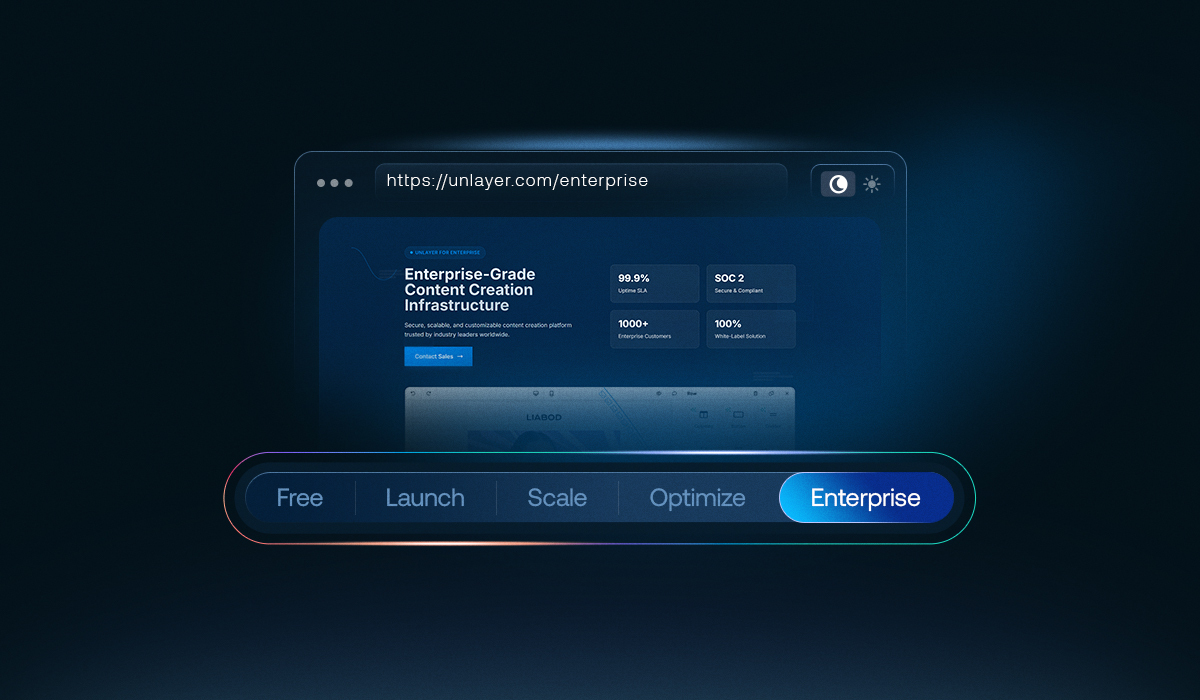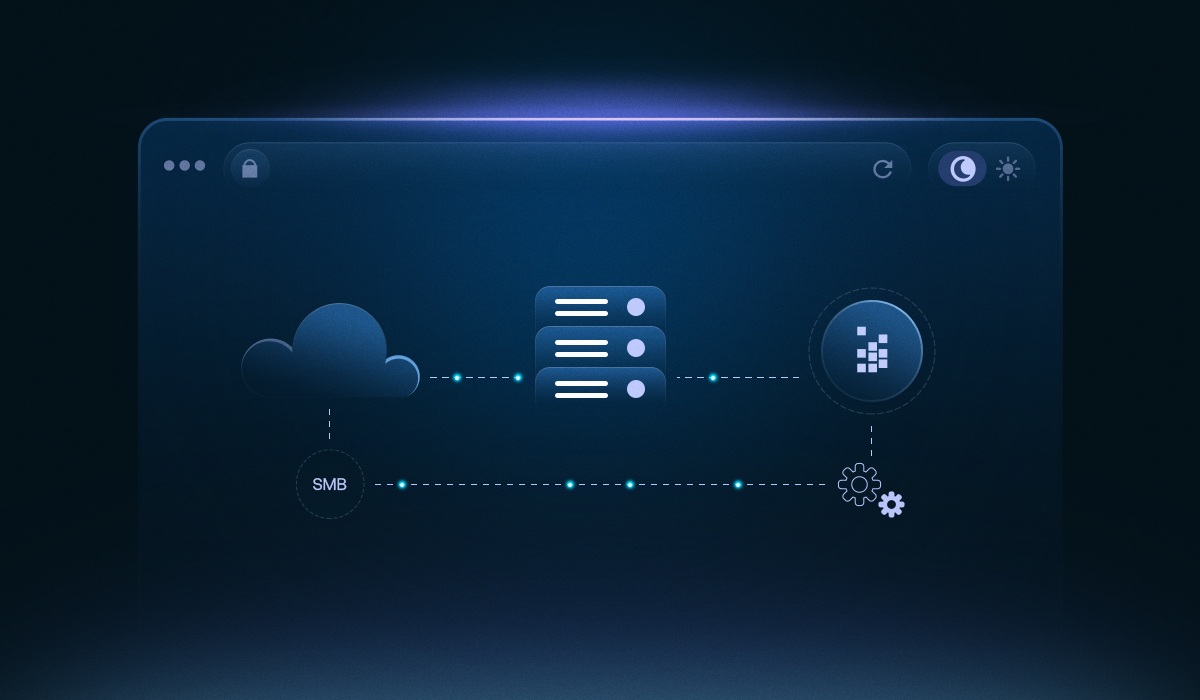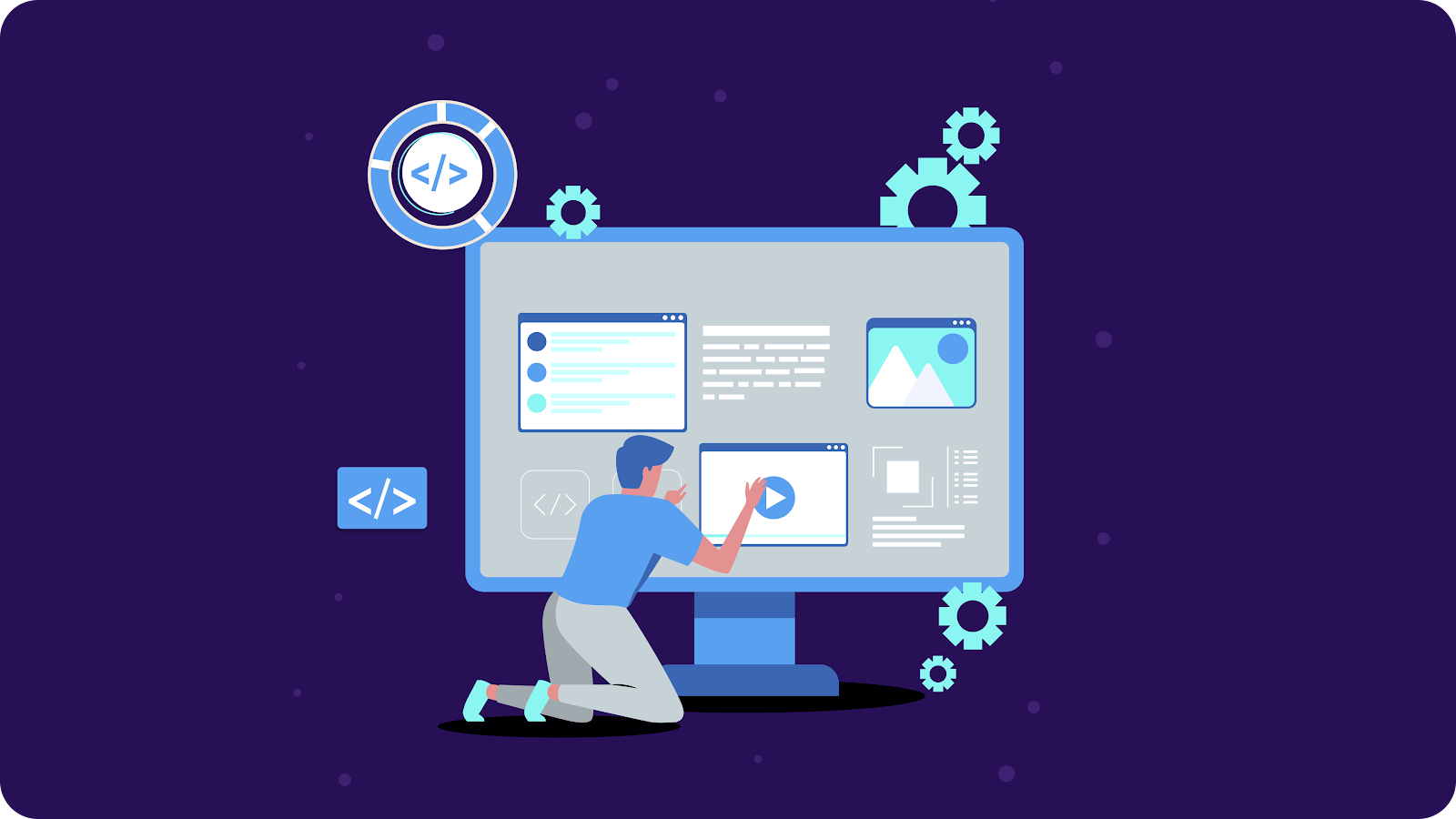Enterprises operate at a scale where every tool must balance performance, reliability, and security. Managing email and content creation across distributed teams, multiple markets, and high-volume campaigns is no small feat.
Traditional editors often fail under the weight of enterprise demands, lacking flexibility, compliance readiness, and integration depth.
That’s where a scalable email builder like Unlayer comes in.
Purpose-built for enterprise-level performance, Unlayer allows large organizations to embed, customize, and govern powerful design tools without overburdening developers or sacrificing compliance.
Key takeaways:
By the end of this blog, you’ll understand:
The pain points enterprises face when managing large-scale content and email tools
Why scalability, compliance, and integration are critical factors in tool selection
How Unlayer delivers enterprise-level performance with features like robust APIs, role-based permissions, and global scalability
Real-world examples of enterprises leveraging Unlayer to save development time and reduce costs
A roadmap for how your enterprise can implement Unlayer for long-term success
Enterprise Pain Points and How Unlayer Solves Them
Running email and content tools at enterprise scale is vastly different from small or mid-sized business needs.
Enterprises face the challenge of managing massive user bases, compliance mandates, global reach, and integration into complex tech stacks.
Below, we’ll discuss the major pain points enterprises face and how Unlayer addresses them head-on with enterprise-grade performance.
1. Scalability & reliability
The pain point:
At enterprise scale, reliability is non-negotiable. You need tools that can:
support thousands (or tens of thousands) of users concurrently
manage high volumes of email sends, design edits, API calls without lag or failure
endure heavy API traffic, both internal (design editors, template saving, export) and external (embedded usage by clients, integrations)
If the underlying system lags, goes down, or becomes unreliable:
Teams are blocked: designers can’t save or publish work, marketers can’t send campaigns, and customer support can’t respond promptly.
Brand reputation is damaged: clients/customers expect seamless communication, so repeated downtimes erode trust.
Revenue gets hit (roughly 9% profits loss): missed email sends, lost orders, dropped conversions.
Enterprises operating in multiple geographies need infrastructure and tooling that behaves consistently everywhere; localized failures (or lag) can degrade the user experience or violate regional compliance/SLA expectations.
Unlayer: Built for scalability & reliability

Unlayer is designed with scalability at its core. Its distributed infrastructure and global CDN ensure fast load times, even for teams spread across multiple continents.
With a guaranteed 99.9% uptime SLA, enterprises can trust that campaigns will run smoothly at scale. Whether embedding Unlayer into a single platform or across multiple tenants, performance remains consistent and dependable.
Takeaway:
Unlayer removes scale-related risks by delivering reliable performance backed by global infrastructure and uptime guarantees.
2. Security, compliance & governance
The pain point:
Enterprises operate under strict data protection laws like GDPR, SOC 2, HIPAA (for healthcare and similar regulated industries), and internal IT governance policies.
Compliance isn’t just a box to tick anymore. It’s a safeguard against financial loss, data breaches, and reputational harm.
Without strong security and governance frameworks, enterprises risk:
Data breaches exposing sensitive customer or company information
Regulatory penalties, which can reach up to €20 million or 4% of annual global turnover under GDPR
Loss of customer trust and brand credibility after compliance failures
Internal risks from unrestricted user access or a lack of audit visibility
Enterprises also need fine-grained user controls to manage access across departments, regions, and hierarchies, something traditional editors rarely support.
Unlayer’s security & compliance features:

Unlayer is SOC 2 Type II certified and GDPR compliant, ensuring enterprise-grade data protection and privacy.
All information is encrypted in transit and at rest, safeguarding assets from interception or unauthorized access.
The platform includes multiple layers of security, such as:
DDoS protection to prevent service disruption
Regular vulnerability scans and secure network architecture
Backup and recovery protocols to protect data integrity
For governance, Unlayer provides role-based access control, detailed audit logs, and Single Sign-On (SSO) with SAML and OAuth support.

These features make it easy for IT teams to enforce security policies, control user permissions, and monitor activities across distributed teams without creating workflow friction.
Takeaway:
Unlayer meets enterprise-level security and compliance standards while giving admins the tools to maintain complete control, accountability, and peace of mind across large, distributed teams.
3. Integration & customization
The pain point:
For enterprises, scalability isn’t just about handling volume; it’s about how well new tools fit into an existing ecosystem.
Most organizations already have multiple platforms running in parallel: CRM systems (like Salesforce, HubSpot), marketing automation tools (Marketo), and in-house applications.
When these systems don’t connect seamlessly, teams face:
Integration bottlenecks: Developers waste hours maintaining APIs or syncing design data manually.
Fragmented workflows: Designers, marketers, and engineers end up working in silos, using different tools with inconsistent outputs.
Inflexibility: Many off-the-shelf editors lock users into predefined templates, making it challenging to match brand guidelines or customize the UI to enterprise workflows.
This lack of cohesion not only slows down production but also drives up developer costs.
In fact, according to Postman’s 2023 State of the API Report, 26% of developers spend over 20 hours per week working with APIs, showing how deeply API-related work consumes engineering time at scale.
Unlayer: API-first architecture, white-labeling, extensibility & custom integrations
Unlayer is designed to integrate deeply and flexibly into enterprise environments, giving both developers and end-users full control.
Embed anywhere: With Unlayer’s embeddable editors (email, landing page, popup, document), enterprises can seamlessly integrate drag-and-drop design capabilities into existing applications via a lightweight JavaScript SDK or plugins like React, Angular, and Vue.
Related: Unlayer SDK: A Comparison of Options for React, Angular & Vue
Custom UI & branding: Every component, from appearance, editor behavior and content settings to style panels, is fully customizable, so you can create branded experiences consistent with your platform’s look and feel.
Custom tools & extensions: Unlayer allows developers to build and integrate custom tools, giving you the flexibility to extend editor functionality with bespoke features that align with your workflows and product goals.
Dynamic content support: With dynamic content, you can personalize designs at scale, inserting user-specific or event-driven data (like names, offers, or locations) to improve engagement and conversion rates.
Extensive API coverage: Developers can access templates and export designs, and even load and save those via REST APIs, streamlining workflows and reducing custom code overhead.
Third-party ecosystem support: Unlayer integrates easily with CRMs, marketing tools, and ESPs through direct connectors or custom webhooks.
Multi-tenant flexibility: Large organizations can run multiple Unlayer instances (or tenants) under one environment, perfect for agencies, marketplaces, or SaaS tools serving multiple brands.
Takeaway:
Unlayer removes integration friction and gives enterprises developer-grade control with a no-code approach. Whether embedding into your app or customizing design workflows, it scales without compromising performance, branding, or flexibility.
4. Operational efficiency & developer cost savings
The pain point:
For most enterprises, building and maintaining an in-house email or page editor quickly becomes a long-term operational burden.
What starts as a simple internal project often turns into a complex, resource-draining effort:
High development costs: Developers spend months building core editor functions such as drag-and-drop components, responsive layouts, and compatibility checks, instead of improving the core product.
Ongoing maintenance: Every update to browsers, email clients, or frameworks demands fixes and testing to prevent rendering issues.
Support & QA overhead: Enterprises need to maintain dedicated QA and support cycles just to ensure the editor keeps working across multiple devices, clients, and integrations.
Opportunity cost: Engineering talent that could be driving product innovation or customer-facing features ends up tied to editor maintenance.
The Stripe report found that developers spend up to 41% of their time dealing with technical debt and maintenance, costing the global economy an estimated $85 billion annually in lost productivity.
That’s time and budget enterprises can’t afford to waste.
Related: 7 Hidden Costs of Building an In-House Email & Page Builder
Unlayer’s operational & dedicated support benefits:

Unlayer replaces the complexity of building and maintaining internal design editors with a fully managed, enterprise-ready solution that accelerates deployment and reduces engineering overhead.
Accelerated time-to-market: Enterprises can embed Unlayer’s editors in days, cutting development cycles by up to 80% and enabling faster product launches.
Lower developer burden: Ongoing maintenance, browser updates, and feature rollouts are handled by Unlayer, freeing your teams to focus on core innovation instead of infrastructure upkeep.
Always compatible: Regular platform updates ensure smooth operation across devices, ESPs, and integrations, which means no manual intervention is required.
Dedicated enterprise support: From onboarding and migration to tailored SLAs and training, Unlayer’s support team ensures smooth implementation and measurable ROI.
Reliable at scale: Backed by a global CDN and 99.9% uptime SLA, Unlayer guarantees consistent performance even for organizations managing millions of templates and emails.
Takeaway:
Unlayer helps enterprises dramatically cut developer costs and operational overhead by replacing homegrown systems with a fully managed, scalable email builder.
Adopting a ready-to-integrate solution delivers faster ROI, reduces maintenance risks, and keeps teams focused on product innovation rather than infrastructure management.
Related: When to Build vs. When to Buy an Embeddable Content Builder
Real-World Use Cases / Success Stories
Enterprises across industries have already leveraged Unlayer to accelerate development, improve user experience, and scale content creation without expanding their engineering footprint.
Here’s how leading brands like Keap, Hive, and TargetBay achieved measurable results.
Keap
Pain point & goal:
With 20+ years of experience and a client base of 200,000+ entrepreneurs, Keap needed a reliable, consistent email builder to match its scale. However, maintaining multiple in-house versions became a major bottleneck.
Therefore, they were looking for a scalable, unified email builder that reduced development overhead and let engineers focus on core innovation, not rebuilding editors.
Outcome with Unlayer:
By embedding Unlayer, Keap conservatively saved ~1 year of development time on its editor efforts. This allowed them to redirect engineering bandwidth toward core product enhancements and speed up overall feature rollout.

Hive
Pain point & goal:
Hive, a marketing software company sending 50+ million emails monthly, needed a high-quality email builder, one that didn’t drain development time or resources.
Building and maintaining an in-house editor would require countless hours and dollars, plus constant updates to accommodate evolving email-client requirements. As their CTO, Patrick put it:
“We didn’t have months of bandwidth available (nor did we want to wait that long) to build/ship such a polished product in-house.”
Unlayer solution & results:
$50,000 in development and maintenance costs saved yearly
40% more leads closed after embedding Unlayer
10,000+ hours saved cumulatively since using Unlayer

TargetBay
Pain point & goal:
As a marketing automation platform, TargetBay wanted to make email design effortless for its customers, so they can enable anyone to create professional campaigns in minutes.
But developing a state-of-the-art email builder in-house required substantial engineering bandwidth and long development cycles that the team couldn’t afford.
Results with Unlayer:
TargetBay’s users saved 8,000+ hours in email design time by using Unlayer’s drag-and-drop editor.

How to Get Started with Unlayer?
The success stories of Keap, Hive, and TargetBay show what’s possible when enterprises adopt a scalable email builder designed for performance and flexibility.
Once the decision to implement Unlayer is made, the next step is straightforward: choosing the right embedding strategy and setting up integrations that fit your technical environment.
1. Choose your deployment model
Unlayer Enterprise supports multiple deployment options such as self-hosted, cloud, or on-premise, giving you full control over data residency, compliance, and performance.
2. Integrate with your stack
You can embed Unlayer using JavaScript SDKs and REST APIs to handle design loading, saving, and export operations seamlessly within existing systems.
Related: Integrating an Email/Page Builder in SaaS: A Quick Guide
3. Framework-specific setup
Unlayer provides detailed implementation guides and code examples for React, Angular, and Vue, ensuring a smooth integration experience across front-end frameworks.
4. Troubleshoot with confidence
Comprehensive documentation and troubleshooting resources help you resolve framework-specific issues quickly and maintain consistent editor performance post-deployment.
5. Access developer resources
For technical teams, Unlayer’s documentation hub includes examples, best practices, and customization guides, all designed to accelerate implementation while maintaining enterprise-grade security and scalability.
Conclusion
In a landscape where enterprises demand speed, reliability, and compliance, choosing the right embeddable tool is crucial.
A scalable email builder like Unlayer enables organizations to streamline content creation, reduce engineering complexity, and maintain performance at scale, all while meeting the highest security and compliance standards.
Ready to build at enterprise scale?
Explore Unlayer Enterprise to see how your organization can design smarter, faster, and more efficiently.
FAQs About Unlayer for Enterprises
1. What makes Unlayer different from other scalable email builders?
Unlayer is built for enterprise-grade performance, offering global CDN support, 99.9% uptime, and full API-driven customization. These are the sort of features rarely found together in traditional email builders. 😉
2. How does the Unlayer Enterprise plan differ from the Self-Serve (Launch, Scale, Optimize) options?
The Enterprise plan offers a fully customizable setup with pricing available on request. It includes everything in the Optimize plan, along with advanced capabilities like:
Brand Style Guide
Custom OpenAI connector
Custom exporters
Server-side rendering
Multi-language support
Early access to new features and delayed releases
On-premise or offline deployment support
Priority support with a dedicated Customer Success Manager (CSM), custom agreements, and enterprise-grade security and continuity.
3. Can Unlayer be deployed on-premise for stricter compliance requirements?
Yes. Unlayer Enterprise supports on-premise, cloud, and self-hosted deployments, giving organizations flexibility to meet internal IT and data residency policies.
4. How customizable is Unlayer’s editor interface?
Every aspect of Unlayer, from the UI layout and editor behavior to custom blocks and styling, can be tailored through advanced customization options, custom tools, and blocks, ensuring brand consistency across products.
5. What kind of support does Unlayer provide for enterprise clients?
Enterprise customers get dedicated success managers, custom SLAs, 24/7 technical support, and training resources to ensure smooth implementation and long-term adoption.
6. Is Unlayer secure and compliant with global standards?
Yes. Unlayer is SOC 2 Type II certified and GDPR compliant, with end-to-end encryption, DDoS protection, audit logs, and access controls to safeguard enterprise data.
7. Are there any usage limits in the Enterprise plan like in Self-Serve plans?
No! Unlike Self-Serve plans such as Optimize, which have predefined limits (e.g., user count), Enterprise offers fully flexible configurations tailored to each organization’s needs.





